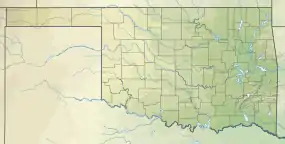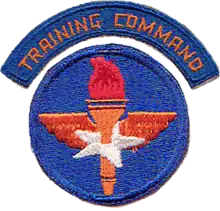Ponca City Regional Airport
Ponca City Regional Airport (IATA: PNC, ICAO: KPNC, FAA LID: PNC) is a city-owned airport two miles northwest of Ponca City, in Kay County, Oklahoma.[1] Enrique's is a well known Mexican restaurant in the terminal.
Ponca City Regional Airport | |||||||||||
|---|---|---|---|---|---|---|---|---|---|---|---|
 USGS 2006 orthophoto | |||||||||||
| Summary | |||||||||||
| Airport type | Public | ||||||||||
| Owner | City of Ponca City | ||||||||||
| Serves | Ponca City, Oklahoma | ||||||||||
| Elevation AMSL | 1,008 ft / 307 m | ||||||||||
| Coordinates | 36°43′55″N 097°05′59″W | ||||||||||
| Map | |||||||||||
 PNC  PNC | |||||||||||
| Runways | |||||||||||
| |||||||||||
| Statistics (2008) | |||||||||||
| |||||||||||
Scheduled passenger flights on Great Lakes Airlines to Denver and Dodge City ended in August, 2006. The service was subsidized by the Essential Air Service program.
History
The January 1938 directory[2] says Ponca City's airport was sod, a half-mile square; in November 1938 a 3,600-foot (1,100 m) concrete runway opened. The United States Army Air Forces took over the facility in the summer of 1941 and used it as part of the British Flying Training School Program. This training was part of the Lend-Lease act where Royal Air Force flying cadets received a 20-week basic flying course taught by civil contractors. The Darr School of Aeronautics provided flight training. Fairchild PT-19s were the primary trainer at the airfield, but PT-17 Stearmans and P-40 Warhawks were also assigned to training.
In November 1942 Royal Air Force training ended at Miami and the airfield became a primary (stage 1) pilot training airfield assigned to AAF Flying Training Command, Gulf Coast Training Center (later Central Flying Training Command). The civil instructors were retained under USAAF control by the 323d Flying Training Detachment.
Pilot training at the airfield apparently ended on May 30, 1944, with the reduced demand for new pilots. The airfield was returned to the local government at the end of the war.
Historical Airline Service
Airline service to Ponca City began in the late 1920's when National Air Transport, d/b/a as United Airlines flew from Chicago to Dallas via Burlington, IA, Kansas City, Wichita, Ponca City, Oklahoma City, and Fort Worth. Braniff Airways, later known as Braniff International Airways, took this route over in 1934. Braniff resumed flights to Ponca City in 1946.
Central Airlines replaced Braniff in 1953-54, using Douglas DC-3s and, in the 1960s, 40-seat Convair 600's. In 1967 Central merged with Frontier Airlines (1950-1986) and Frontier continued to serve Ponca City with the 50-seat Convair 580. Frontier ended their service in 1979 after the passing of the Airline Deregulation Act and Ponca City then only saw service by small commuter airlines.[3][4]
Air Midwest served Ponca City from 1979 until 1981 with nonstop Fairchild Swearingen Metroliner II's to Wichita and one-stops to Oklahoma City.[5]
Metro Airlines served from 1981 to 1986 with one-stop de Havilland Canada DHC-6 Twin Otters to Oklahoma City.[6]
Exec Express began service in 1986 with Piper PA-31 Navajos to Tulsa. Exec Express changed names three times over the next ten years, first to Exec Express II in 1988, then Lone Star Airlines in 1991, and finally Aspen Mountain Air in 1996. Service switched from Tulsa to Dallas/Fort Worth by the late 1980's and Fairchild Swearingen Metroliners replaced the Navajos. The airline went out of business in late 1998.[7]
Big Sky Airlines took over serving Ponca City in 1999 with flights to Dallas/Fort Worth and to Denver with one stop at Enid, OK. Big Sky also used Metroliners but ended service in 2002.[8]
Mesa Airlines followed from 2002 to 2005 with Beechcraft 1900Ds to Dallas/Fort Worth and Denver..[9]
Great Lakes Airlines was the final carrier at Ponca City, in 2005-2006 with one stop Beechcraft 1900Ds to Denver.[10]
Passengers now prefer to drive to larger cities for air travel; Ponca City has not seen airline service since August, 2006.
Facilities
The airport covers 500 acres (202 ha) at an elevation of 1,008 feet (307 m). Its single runway, 17/35, is 7,201 by 150 feet (2,195 x 46 m) concrete.[1]
In the year ending August 26, 2008 the airport had 61,500 aircraft operations, average 168 per day: 93% general aviation and 7% military. 64 aircraft were then based at this airport: 91% single-engine, 5% multi-engine, 3% jet, and 2% ultralight.[1] There are multiple hangars on the grounds, and the Northern Oklahoma Flight Academy is based there.
See also
References
- FAA Airport Form 5010 for PNC PDF. Federal Aviation Administration. Effective April 5, 2012.
- https://babel.hathitrust.org/cgi/pt?id=pst.000070955835&view=1up&seq=167
- "Central Airlines, Effective June 5, 1950". Timetableimages.com. Retrieved October 1, 2020.
- "Central Airlines, Effective July 1, 1967". Timetableimages.com. Retrieved October 1, 2020.
- Air Midwest timetables
- Metro Airlines timetables
- Exec Express, Lone Star, and Aspen Mountain Air timetables
- Big Sky Airlines timetables
- American Express Skyguide editions from 2002 through 2005
- American Express Skyguide editions from 2005 through 2006
Other sources
 This article incorporates public domain material from the Air Force Historical Research Agency website http://www.afhra.af.mil/.
This article incorporates public domain material from the Air Force Historical Research Agency website http://www.afhra.af.mil/.- Shaw, Frederick J. (2004), Locating Air Force Base Sites History's Legacy, Air Force History and Museums Program, United States Air Force, Washington DC, 2004.
- Essential Air Service documents (Docket OST-1997-2401) from the U.S. Department of Transportation:
- Order 2002-7-2 (July 5, 2002): selecting Air Midwest, Inc., to provide essential air service at seven communities (El Dorado/Camden, AR; Jonesboro, AR; Harrison, AR; Hot Springs, AR; Enid, OK; Ponca City, OK; Brownwood, TX) for a two-year period at subsidy rates totaling $6,693,881 annually.
- Order 2004-6-12 (June 17, 2004): requests interested persons to show cause why it should not terminate the essential air service subsidy eligibility of Jonesboro, Arkansas, Enid and Ponca City, Oklahoma, and Brownwood, Texas, and allow Air Midwest to suspend its subsidized services at those communities as of October 1, 2004, when the current rate term expires.
- Order 2005-1-14 (January 25, 2004): selecting Air Midwest, Inc., to provide essential air service at El Dorado/Camden, Jonesboro, Harrison and Hot Springs, Arkansas, at a subsidy rate of $4,155,550 annually for a two-year rate term, selecting Great Lakes Aviation, Ltd., to provide essential air service at Enid and Ponca City, Oklahoma at a subsidy rate of $1,272,557 annually for allowing Air Midwest to discontinue its service there, if it chooses to do so.
- Order 2006-7-25 (August 1, 2006): terminating the essential air service subsidy eligibility of Enid and Ponca City, Oklahoma, and allowing Great Lakes Aviation, Ltd., to suspend service at the two communities as of September 1, 2006, if it chooses.
External links
- "Ponca City Airport Industrial Park" (PDF). Archived from the original (PDF) on 2006-10-30. (595 KB)
- Aerial image as of February 1995 from USGS The National Map
- FAA Terminal Procedures for PNC, effective January 28, 2021
- Resources for this airport:
- FAA airport information for PNC
- AirNav airport information for KPNC
- ASN accident history for PNC
- FlightAware airport information and live flight tracker
- NOAA/NWS weather observations: current, past three days
- SkyVector aeronautical chart, Terminal Procedures
